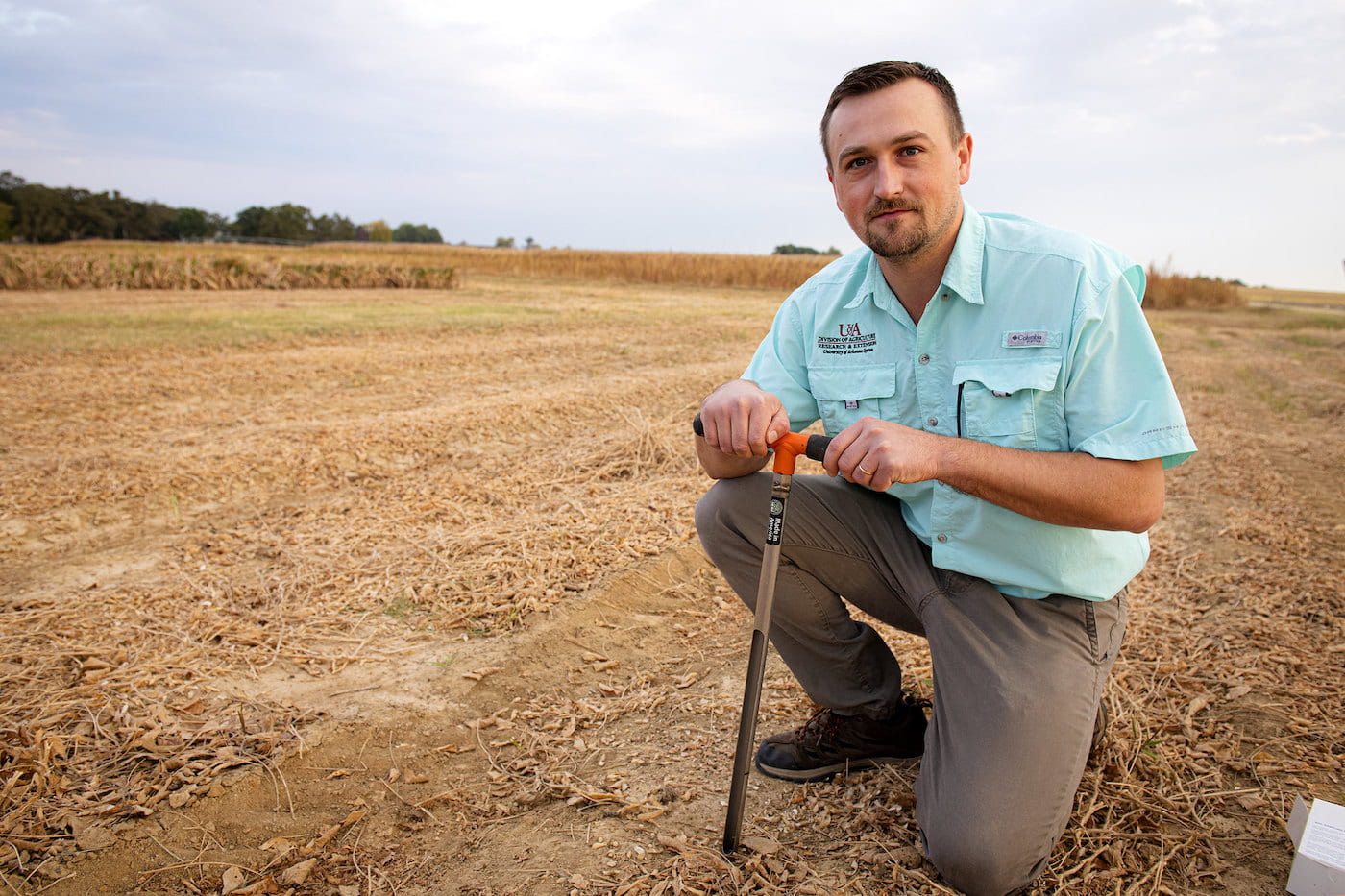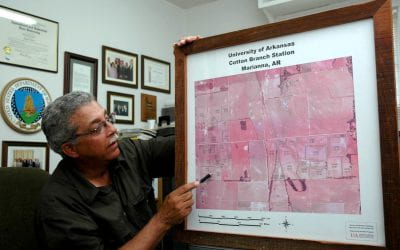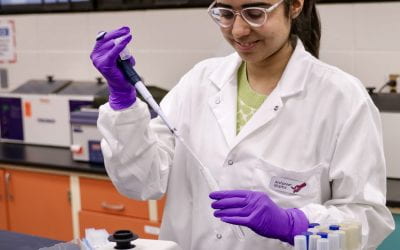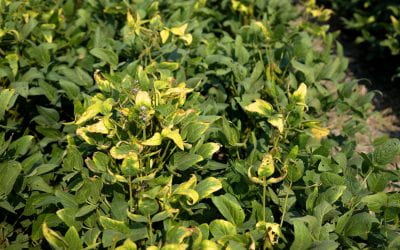Arkansas Study Shows Soil Nutrient Test Results Can Vary When Soil is Very Dry
Soil sampling study identifies optimum soil moisture range for uniform soil core sampling
By John Lovett – Oct. 19, 2022

MEDIA CONTACT
John Lovett
U of A System Division of Agriculture
Arkansas Agricultural Experiment Station
(479) 763-5929 | jlovett@uada.edu
FAYETTEVILLE, Ark. — Very dry conditions, like those seen in most of Arkansas this fall, impact two aspects of soil sampling that make it hard to measure how much phosphorus and potassium are in a field.
Arkansas Agricultural Experiment Station research shows potassium and phosphorus levels varied based on soil sample integrity and the time of year the sample was taken.
Core integrity
“What we saw is that soil test results can change depending on the soil moisture situation at the time of sampling,” said Gerson Drescher, assistant professor of soil fertility with the experiment station, the research arm of the University of Arkansas System Division of Agriculture. “The most pronounced effects for fertilizer rate recommendations are seen on potassium and phosphorus when the soil is either too dry or too wet.”
“During a typical soil sampling season, we can have extremely dry soil conditions, such as this year, to extremely wet conditions as observed in the fall of 2018,” said Nathan Slaton, professor of soil fertility. “One of the issues with both situations is the integrity of the soil cores that are collected. When the soil is too dry or too wet, sampling to the proper depth can be difficult.”
Slaton is also an associate vice president of agriculture and assistant director of the experiment station.
Their study, funded through fertilizer tonnage fees administered by the Arkansas Soil Test Review Board, showed that soil moisture conditions at the time of sampling had little to no effect on collecting samples to a 4-inch depth. However, collecting samples to a 6-inch depth was much more difficult. When soil moisture was below 20 percent, the soil probe could be inserted to only about 5 inches, Drescher said.
Soil nutrients, such as phosphorus and potassium, are usually stratified in the soil profile. Greater concentrations of nutrients are found near the soil surface where fertilizers are typically applied and crop residues are deposited, Drescher said. When soil samples are taken from a shallower depth than intended, the soil test phosphorus and potassium tend to be greater.
In the Arkansas study, based on silt loam soils low in potassium, soil test potassium was 15-20 percent higher in very dry soil conditions where soil cores were closer to 5 inches, rather than the target depth of 6 inches. This fluctuation in soil test potassium was large enough to change the fertilizer recommendations. A similar behavior was also observed for phosphorus.
The results suggest that the change in soil test potassium and phosphorus compared to samples taken in moist soil at the same time was due to sample depth. Drescher said that other studies in the Midwest have also shown that soil mineralogy in very dry soil conditions can influence soil test potassium values, but this effect is less pronounced in Arkansas.
In the Midsouth, most soil samples are now collected in October and November to allow time for collecting the large number of samples needed for grid soil sampling, which allows producers and consultants to see the range of soil test values at regular intervals across a field.
“There is no need to stop collecting samples unless the soil samples cannot be collected to the correct and recommended depth,” Drescher said. “The lime and fertilizer recommendations are only as good as the sample that comes from the field in the first place. It’s paramount to get a good sample that represents the field it comes from.”
Simulating soil moisture levels that ranged from very dry to muddy, they found the optimum moisture level for soil core integrity and soil-test result reproducibility was near field capacity moisture, around 25-35 percent moisture. The “very dry” samples registered about 15-20 percent moisture, and the very wet samples registered about 50 percent moisture.
“You see much less variability in the soil-test results when you have moist soil conditions,” Drescher said. “Collecting a representative sample to the proper depth plays a major role in accurate fertilizer rate recommendations, and moist soil conditions also make soil sampling much easier in the field.”
MEDIA CONTACT
John Lovett
U of A System Division of Agriculture
Arkansas Agricultural Experiment Station
(479) 763-5929 | jlovett@uada.edu

DUST TO DUST — Dry soil is difficult to puncture with a soil probe, and a probe that is not driven deep enough can lead to an inaccurate soil test result. (U o A Division of Ag photo by Fred Miller)
Let it Rain
A previous study by Slaton evaluating potassium and phosphorus fluctuations showed soil test potassium levels could vary by as much as 25 parts-per-million when a sample was taken in rice fields before rain leached out the nutrient from crop residue. This study was supported by fertilizer tonnage fees and check-off funds administered by the Arkansas Soybean Promotion Board and the Arkansas Rice Research and Promotion Board.
While soil microbes must decompose crop residues to mineralize phosphorus and nitrogen, potassium leaches directly into the soil from crop residue, Drescher explained.
“Potassium is a nutrient found mostly in the plant’s cell solution, so it’s not part of structural plant parts like cell walls,” Drescher said. “That means it just needs some rainfall, and the potassium in the plant biomass will return to the soil.”
For farmers who burn their crop residue, Drescher said the potassium in ashes would be moved around a field with the wind or rain, which may increase field variability. While fire is a common management tool for dealing with crop residue, Drescher said recent research shows this practice removes nearly all of the nitrogen and carbon in the crop residue from the field.
Timing is Key
The time of year a soil test is taken can also have an impact on pH levels. In Arkansas, Drescher said soil pH can vary by plus or minus 0.5 pH units throughout the year, with lower soil pH usually found in dry summer and post-harvest fall conditions. Greater pH values are usually found in winter and the early spring months. Depending on the initial pH, that fluctuation can affect a lime recommendation in the next season.
“For people who have already collected their soil samples in dry soil conditions, it is important to have in mind that in some circumstances the soil test report might call for a lime application when it is not really required,” Drescher said. “If a low pH value is unexpected for a certain field, producers and crop consultants can always collect a few soil samples later in the winter, when soil moisture is adequate, to check if the pH values were skewed or confirm that the field does require a lime application.”
To learn more about the Division of Agriculture research, visit the Arkansas Agricultural Experiment Station website: https://aaes.uada.edu. Follow us on Twitter at @ArkAgResearch and Instagram at @ArkAgResearch.
To learn about Extension Programs in Arkansas, contact your local Cooperative Extension Service agent or visit https://uaex.uada.edu/. Follow us on Twitter at @AR_Extension.
To learn more about the Division of Agriculture, visit https://uada.edu/. Follow us on Twitter at @AgInArk.
About the Division of Agriculture
The University of Arkansas System Division of Agriculture’s mission is to strengthen agriculture, communities, and families by connecting trusted research to the adoption of best practices. Through the Agricultural Experiment Station and the Cooperative Extension Service, the Division of Agriculture conducts research and extension work within the nation’s historic land grant education system.
The Division of Agriculture is one of 20 entities within the University of Arkansas System. It has offices in all 75 counties in Arkansas and faculty on five system campuses.
The University of Arkansas System Division of Agriculture offers all its Extension and Research programs and services without regard to race, color, sex, gender identity, sexual orientation, national origin, religion, age, disability, marital or veteran status, genetic information, or any other legally protected status, and is an Affirmative Action/Equal Opportunity Employer.
DUST TO DUST — Dry soil is difficult to puncture with a soil probe, and a probe that is not driven deep enough can lead to an inaccurate soil test result. (U o A Division of Ag photo by Fred Miller)
More Recent News
Claude Kennedy, Retired Cotton Station Director, Former ASCS Regional Director, Passes Away at 82
Kennedy, with his radiant smile and outstretched hands, would welcome visitors and instantly make them feel at home. More often than not, a first-time visitor would get a tour and offer of lunch, regardless of what else was on Kennedy’s calendar that day. By Mary...
New Parasite Affecting Canadian Partridges Named for Arkansas Poultry Scientist
Canadian researchers name new Eimeria parasite species after Arkansas scientist By John Lovett – Apr. 16, 2024 NAMESAKE — Billy Hargis, Distinguished Professor of poultry science for the Arkansas Agricultural Experiment...
Food Scientists are Finding Ways to Preserve Food Quality and Ensure Food Safety
Food scientists develop framework to improve food quality and still kill pathogens By John Lovett – Apr. 12, 2024 QUALITY CONTROL — Arshpreet Khattra was the lead author of a study that developed a framework for food...
Claude Kennedy, Retired Cotton Station Director, Former ASCS Regional Director, Passes Away at 82
Kennedy, with his radiant smile and outstretched hands, would welcome visitors and instantly make them feel at home. More often than not, a first-time visitor would get a tour and offer of lunch, regardless of what else was on Kennedy’s calendar that day. By Mary...
New Parasite Affecting Canadian Partridges Named for Arkansas Poultry Scientist
Canadian researchers name new Eimeria parasite species after Arkansas scientist By John Lovett – Apr. 16, 2024 NAMESAKE — Billy Hargis, Distinguished Professor of poultry science for the Arkansas Agricultural Experiment...
Food Scientists are Finding Ways to Preserve Food Quality and Ensure Food Safety
Food scientists develop framework to improve food quality and still kill pathogens By John Lovett – Apr. 12, 2024 QUALITY CONTROL — Arshpreet Khattra was the lead author of a study that developed a framework for food...
USDA-Grant Supported FRST Project Releases New Fertilizer Prediction Tool
Fertilizer recommendation tool for farmers could save money and reduce nutrient loss By John Lovett – Apr. 8, 2024 DECISION AID — Farmers have a new fertilizer decision aid available called FRST (Fertilizer...




